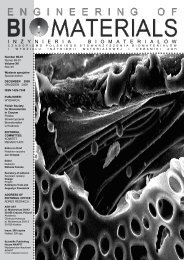69-72 - Polskie Stowarzyszenie BiomateriaÅów
69-72 - Polskie Stowarzyszenie BiomateriaÅów
69-72 - Polskie Stowarzyszenie BiomateriaÅów
You also want an ePaper? Increase the reach of your titles
YUMPU automatically turns print PDFs into web optimized ePapers that Google loves.
RYS.2. Model dyskretny układu kość – cement -<br />
trzpień z widoczną siatką elementów skończonych<br />
oraz przykłady rozkładu temperatury.<br />
FIG.2. FEM model of the bone-cement-stem system<br />
with a finite elements lattice and an example<br />
of temperature distribution.<br />
RYS.1. Charakterystyka źródła ciepła z zaznaczonym,<br />
przyjętym do obliczeń, czasem trwania procesu<br />
polimeryzacyjnego wzrostu temperatury.<br />
FIG.1. Heat source characteristics with a marked,<br />
assumed for calculations.<br />
100 dyskretny o liczbie węzłów równej 48<strong>72</strong>4 (rys.2) [7].<br />
W procesie modelowania przyjęto dwa rodzaje warunków<br />
brzegowych (tabela 1). Na zewnętrznej powierzchni<br />
kości oraz odsłoniętych częściach metalowego trzpienia<br />
zadano warunek brzegowy III-go rodzaju, odpowiadający<br />
konwekcyjnej wymianie ciepła z zadanym odpowiednim<br />
współczynnikiem przejmowania ciepła i temperaturą otoczenia.<br />
Wartość wewnętrznego źródła ciepła była wyznaczona<br />
na podstawie badań eksperymentalnych publikowanych<br />
w pracy [4]. Właściwości termofizyczne (tabela 2) kości,<br />
cementu, metalu przyjęto na podstawie literatury [3,5].<br />
Przykładowe rozkłady temperatury w udowej kości z wprowadzonym<br />
trzpieniem endoprotezy pokazano na rys.2.<br />
Rejestrowano zmieniające się w czasie rozkłady temperatury.<br />
Jednym z miejsc pomiaru temperatury był punkt przy<br />
wierzchołku implantu, gdzie warstwa cementu osiąga największą<br />
grubość (rys.3) i wymiana ciepła przez metalowy<br />
trzpień jest najmniej intensywna, maksymalna temperatura<br />
w tym miejscu wynosiła 56,5°C. Punkt środkowy zlokalizowano<br />
w obszarze, gdzie grubość warstwy cementowej<br />
wynosiła około 2,3mm, maksymalna temperatura osiągnęła<br />
48,7°C. Grubość warstwy cementu otaczającej kołnierz<br />
wynosiła 2,7mm. W tym obszarze, wymiana ciepła z mein<br />
the FEM program, in which a discrete model was created<br />
with the number of nodes equal 48<strong>72</strong>4 (Fig.2) [7].<br />
Two types of boundary conditions were assumed (table 1).<br />
For the bone’s outer surface and uncovered parts of the<br />
metal stem, a third-type boundary condition was prescribed,<br />
corresponding to convective heat exchange with the prescribed<br />
respective surface film conductance and ambient<br />
temperature. The internal heat source intensity value was<br />
determined based on experimental studies published in<br />
paper [4]. The thermophysical properties (table 2) of the<br />
bone, cement and metal were prescribed on the basis of<br />
literature [3,5]. An example of the model application for the<br />
determination of thermal field in the femoral bone with an<br />
endoprosthesis’ stem is shown in Fig.2.<br />
The courses of temperature changes in time were recorded.<br />
One of the temperature measurement point was<br />
located near the top where the cement layer was the thickest<br />
(Fig.3) and heat absorption by the metal stem was the<br />
least intense, were a maximum local temperature of 56°C.<br />
The midpoint was located in an area where the cement layer<br />
thickness was uniform, of ca 2,3mm a maximum temperature<br />
of 48,7°C. Surrounding the flange, the cement thickness also<br />
was about 2,7 mm. However, in that area, heat exchange<br />
with the metal endoprosthesis was more intense its maximum<br />
value of 42,4°C. Figure 4 presents a comparison<br />
of maximum temperatures determined experimentally and<br />
RYS.3. Rozmieszczenie termopar oraz uzyskane grubości<br />
warstwy cementu w miejscach pomiarowych.<br />
FIG. 3. Lateral cross-section of the laboratory<br />
model and method of thermocouples arrangement<br />
in the laboratory model.<br />
RYS.4. Porównanie temperatur maksymalnych wyznaczonych<br />
za pomocą MES i eksperymentalnie przy<br />
użyciu modelu laboratoryjnego.<br />
FIG.4. Comparison of maximum temperatures determined<br />
experimentally and calculated.













